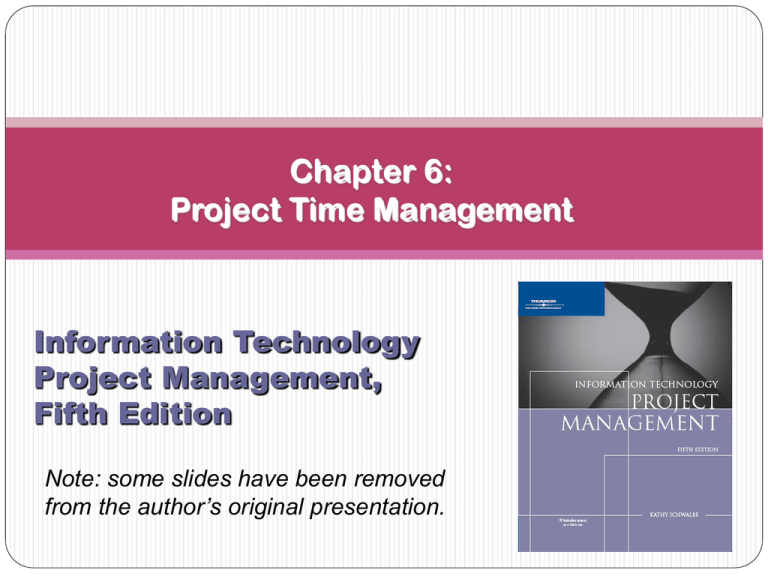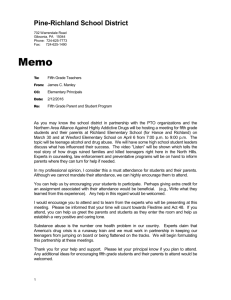network diagram - Seneca - School of Information
advertisement

Chapter 6: Project Time Management Information Technology Project Management, Fifth Edition Note: some slides have been removed from the author’s original presentation. Importance of Project Schedules Managers often cite delivering projects on time as one of their biggest challenges Time has the least amount of flexibility; it passes no matter what happens on a project Schedule issues are the main reason for conflicts on projects, especially during the second half of projects 2 Information Technology Project Management, Fifth Edition, Copyright 2007 Individual Work Styles and Cultural Differences Cause Schedule Conflicts One dimension of the Meyers-Briggs Type Indicator focuses on peoples’ attitudes toward structure and deadline Some people prefer to follow schedules and meet deadlines, while others do not (J vs. P) Different cultures and even entire countries have different attitudes about schedules 3 Information Technology Project Management, Fifth Edition, Copyright 2007 Media Snapshot In contrast to the 2002 Salt Lake City Winter Olympic Games (see Chapter 4’s Media Snapshot), planning and scheduling was very different for the 2004 Summer Olympic Games held in Athens, Greece Many articles were written before the opening ceremonies predicting that the facilities would not be ready in time Many people were pleasantly surprised by the amazing opening ceremonies, beautiful new buildings, and state-ofthe-art security and transportation systems in Athens The Greeks even made fun of critics by having construction workers pretend to still be working as the ceremonies began 4 Information Technology Project Management, Fifth Edition, Copyright 2007 Project Time Management Processes 1. 2. 3. 4. 5. 6. Activity definition: identifying the specific activities that the project team members and stakeholders must perform to produce the project deliverables Activity sequencing: identifying and documenting the relationships between project activities Activity resource estimating: estimating how many resources a project team should use to perform project activities Activity duration estimating: estimating the number of work periods that are needed to complete individual activities Schedule development: analyzing activity sequences, activity resource estimates, and activity duration estimates to create the project schedule Schedule control: controlling and managing changes to the project schedule 5 Information Technology Project Management, Fifth Edition, Copyright 2007 Figure 6-1: Project Time Management Summary 6 Information Technology Project Management, Fifth Edition, Copyright 2007 1. Activity Definition Project schedules grow out of the basic documents that initiate a project Project charter includes start and end dates and budget information Scope statement and WBS help define what will be done Activity definition involves developing a more detailed WBS and supporting explanations to understand all the work to be done so you can develop realistic cost and duration estimates 7 Information Technology Project Management, Fifth Edition, Copyright 2007 Activity Lists and Attributes An activity list is a tabulation of activities to be included on a project schedule that includes: The activity name An activity identifier or number A brief description of the activity Activity attributes provide more information such as predecessors, successors, logical relationships, leads and lags, resource requirements, constraints, imposed dates, and assumptions related to the activity 8 Information Technology Project Management, Fifth Edition, Copyright 2007 Milestones A milestone is a significant event that normally has no duration It often takes several activities and a lot of work to complete a milestone They’re useful tools for setting schedule goals and monitoring progress Examples include obtaining customer sign-off on key documents or completion of specific products 9 Information Technology Project Management, Fifth Edition, Copyright 2007 What Went Wrong? At the U.S. Federal Bureau of Investigation (FBI), poor time management was one of the reasons behind the failure of Trilogy, a “disastrous, unbelievably expensive piece of vaporware, which was more than four years in the (un)making. The system was supposed to enable FBI agents to integrate intelligence from isolated information silos within the Bureau.”* In May 2006, the Government Accounting Agency said that the Trilogy project failed at its core mission of improving the FBI’s investigative abilities and was plagued with missed milestones and escalating costs *Roberts, Paul, “Frustrated contractor sentenced for hacking FBI to speed deployment,” InfoWorld Tech Watch, (July 6, 2006). 10 Information Technology Project Management, Fifth Edition, Copyright 2007 2. Activity Sequencing Involves reviewing activities and determining dependencies A dependency or relationship is the sequencing of project activities or tasks You must determine dependencies in order to use critical path analysis 11 Information Technology Project Management, Fifth Edition, Copyright 2007 Three Types of Dependencies Mandatory dependencies: inherent in the nature of the work being performed on a project, sometimes referred to as hard logic Discretionary dependencies: defined by the project team; sometimes referred to as soft logic and should be used with care since they may limit later scheduling options External dependencies: involve relationships between project and nonproject activities 12 Information Technology Project Management, Fifth Edition, Copyright 2007 Network Diagrams Network diagrams are the preferred technique for showing activity sequencing A network diagram is a schematic display of the logical relationships among, or sequencing of, project activities Two main formats are the arrow and precedence diagramming methods 13 Information Technology Project Management, Fifth Edition, Copyright 2007 Figure 6-2: Sample Activity-onArrow (AOA) Network Diagram for Project X 14 Information Technology Project Management, Fifth Edition, Copyright 2007 Arrow Diagramming Method (ADM) Also called activity-on-arrow (AOA) network diagrams Activities are represented by arrows Nodes or circles are the starting and ending points of activities Can only show finish-to-start dependencies 15 Information Technology Project Management, Fifth Edition, Copyright 2007 Process for Creating AOA Diagrams 1. Find all of the activities that start at node 1: Draw their finish nodes and draw arrows between node 1 and those finish nodes; put the activity letter or name and duration estimate on the associated arrow 2. Continue drawing the network diagram, working from left to right: Look for bursts and merges Bursts occur when a single node is followed by two or more activities A merge occurs when two or more nodes precede a single node 16 3. Continue drawing the project network diagram until all activities are included on the diagram that have dependencies 4. As a rule of thumb, all arrowheads should face toward the right, and no arrows should cross on an AOA network diagram Information Technology Project Management, Fifth Edition, Copyright 2007 Precedence Diagramming Method (PDM) Activities are represented by boxes Arrows show relationships between activities More popular than ADM method and used by project management software Better at showing different types of dependencies 17 Information Technology Project Management, Fifth Edition, Copyright 2007 Figure 6-3: Task Dependency Types 18 Information Technology Project Management, Fifth Edition, Copyright 2007 Figure 6-4: Sample PDM Network Diagram 19 Information Technology Project Management, Fifth Edition, Copyright 2007 3. Activity Resource Estimating Before estimating activity durations, you must have a good idea of the quantity and type of resources that will be assigned to each activity Consider important issues in estimating resources How difficult will it be to do specific activities on this project? What is the organization’s history in doing similar activities? Are the required resources available? A resource breakdown structure is a hierarchical structure that identifies the project’s resources by category and type 20 Information Technology Project Management, Fifth Edition, Copyright 2007 4. Activity Duration Estimating Duration includes the actual amount of time worked on an activity plus elapsed time Effort is the number of workdays or work hours required to complete a task Effort does not normally equal duration People doing the work should help create estimates, and an expert should review them 21 Information Technology Project Management, Fifth Edition, Copyright 2007 5. Schedule Development Uses results of the other time management processes to determine the start and end date of the project Ultimate goal is to create a realistic project schedule that provides a basis for monitoring project progress for the time dimension of the project Important tools and techniques include Gantt charts, critical path analysis, critical chain scheduling, and PERT analysis 22 Information Technology Project Management, Fifth Edition, Copyright 2007 Gantt Charts Gantt charts provide a standard format for displaying project schedule information by listing project activities and their corresponding start and finish dates in a calendar format Symbols include: Black diamonds: milestones Thick black bars: summary tasks Lighter horizontal bars: durations of tasks Arrows: dependencies between tasks 23 Information Technology Project Management, Fifth Edition, Copyright 2007 Adding Milestones to Gantt Charts Many people like to focus on meeting milestones, especially for large projects Milestones emphasize important events or accomplishments on projects Normally create milestone by entering tasks with a zero duration, or you can mark any task as a milestone 24 Information Technology Project Management, Fifth Edition, Copyright 2007 SMART Criteria Milestones should be: Specific Measurable Assignable Realistic Time-framed 25 Information Technology Project Management, Fifth Edition, Copyright 2007 Best Practice Schedule risk is inherent in the development of complex systems Luc Richard, the founder of www.projectmangler.com, suggests that project managers can reduce schedule risk through project milestones, a best practice that involves identifying and tracking significant points or achievements in the project 26 Information Technology Project Management, Fifth Edition, Copyright 2007 Best Practice (continued) The five key points of using project milestones include the following: 1. Define milestones early in the project and include them in the Gantt chart to provide a visual guide 2. Keep milestones small and frequent 3. The set of milestones must be all-encompassing 4. Each milestone must be binary, meaning it is either complete or incomplete 5. Carefully monitor the critical path 27 Information Technology Project Management, Fifth Edition, Copyright 2007 Figure 6-7: Sample Tracking Gantt Chart 28 Information Technology Project Management, Fifth Edition, Copyright 2007 Critical Path Method (CPM) CPM is a network diagramming technique used to predict total project duration A critical path for a project is the series of activities that determines the earliest time by which the project can be completed The critical path is the longest path through the network diagram and has the least amount of slack or float Slack or float is the amount of time an activity may be delayed without delaying a succeeding activity or the project finish date 29 Information Technology Project Management, Fifth Edition, Copyright 2007 Calculating the Critical Path First develop a good network diagram Add the duration estimates for all activities on each path through the network diagram The longest path is the critical path If one or more of the activities on the critical path takes longer than planned, the whole project schedule will slip unless the project manager takes corrective action 30 Information Technology Project Management, Fifth Edition, Copyright 2007 Figure 6-8: Determining the Critical Path for Project X 31 Information Technology Project Management, Fifth Edition, Copyright 2007 More on the Critical Path A project team at Apple computer put a stuffed gorilla on the top of the cubicle of the person currently managing a critical task The critical path is not the one with all the critical activities; it only accounts for time Remember the example of growing grass being on the critical path for Disney’s Animal Kingdom There can be more than one critical path if the lengths of two or more paths are the same The critical path can change as the project progresses 32 Information Technology Project Management, Fifth Edition, Copyright 2007 Using Critical Path Analysis to Make Schedule Trade-offs Free slack or free float is the amount of time an activity can be delayed without delaying the early start of any immediately following activities Total slack or total float is the amount of time an activity may be delayed from its early start without delaying the planned project finish date A forward pass through the network diagram determines the early start and finish dates A backward pass determines the late start and finish dates 33 Information Technology Project Management, Fifth Edition, Copyright 2007 Figure 6-9: Calculating Early and Late Start and Finish Dates 34 Information Technology Project Management, Fifth Edition, Copyright 2007 Table 6-1: Free and Total Float or Slack for Project X 35 Information Technology Project Management, Fifth Edition, Copyright 2007 Using the Critical Path to Shorten a Project Schedule Three main techniques for shortening schedules Shortening durations of critical activities/tasks by adding more resources or changing their scope Crashing activities by obtaining the greatest amount of schedule compression for the least incremental cost Fast tracking activities by doing them in parallel or overlapping them 36 Information Technology Project Management, Fifth Edition, Copyright 2007 Importance of Updating Critical Path Data It is important to update project schedule information to meet time goals for a project The critical path may change as you enter actual start and finish dates If you know the project completion date will slip, negotiate with the project sponsor 37 Information Technology Project Management, Fifth Edition, Copyright 2007 Buffers and Critical Chain A buffer is additional time to complete a task Murphy’s Law states that if something can go wrong, it will Parkinson’s Law states that work expands to fill the time allowed In traditional estimates, people often add a buffer to each task and use it if it’s needed or not Critical chain scheduling removes buffers from individual tasks and instead creates: A project buffer or additional time added before the 38 project’s due date Feeding buffers or additional time added before tasks on the critical path Information Technology Project Management, Fifth Edition, Copyright 2007 Figure 6-11: Example of Critical Chain Scheduling 39 Information Technology Project Management, Fifth Edition, Copyright 2007 6. Schedule Control Perform reality checks on schedules Allow for contingencies Don’t plan for everyone to work at 100% capacity all the time Hold progress meetings with stakeholders and be clear and honest in communicating schedule issues 40 Information Technology Project Management, Fifth Edition, Copyright 2007 Schedule Control (continued) Goals are to know the status of the schedule, influence factors that cause schedule changes, determine that the schedule has changed, and manage changes when they occur Tools and techniques include: Progress reports A schedule change control system Project management software, including schedule comparison charts like the tracking Gantt chart Variance analysis, such as analyzing float or slack Performance management, such as earned value (chapter 7) 41 Information Technology Project Management, Fifth Edition, Copyright 2007 Reality Checks on Scheduling First review the draft schedule or estimated completion date in the project charter Prepare a more detailed schedule with the project team Make sure the schedule is realistic and followed Alert top management well in advance if there are schedule problems 42 Information Technology Project Management, Fifth Edition, Copyright 2007 What Went Right? Chris Higgins used the discipline he learned in the U.S. Army to transform project management into a cultural force at Bank of America; he used the same approach he did for packing tents when he led an interstate banking initiative He made the team members analyze, plan, and document requirements for the system in such detail that it took six months just to complete that phase However, because of his discipline with time management and planning, the software developers on the team finished all of the coding in only three months, and the project was completed on time* *Melymuke, Kathleen, “Spit and Polish,” ComputerWorld (February 16, 1998). 43 Information Technology Project Management, Fifth Edition, Copyright 2007 Using Software to Assist in Time Management Software for facilitating communications helps people exchange schedule-related information Decision support models help analyze trade-offs that can be made Project management software can help in various time management areas 44 Information Technology Project Management, Fifth Edition, Copyright 2007 Words of Caution on Using Project Management Software Many people misuse project management software because they don’t understand important concepts and have not had training You must enter dependencies to have dates adjust automatically and to determine the critical path You must enter actual schedule information to compare planned and actual progress 45 Information Technology Project Management, Fifth Edition, Copyright 2007






